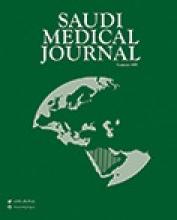Abstract
OBJECTIVES: To evaluate the effect of intravenous immunoglobulin IVIG utilization at King Khalid University Hospital, an 850 bed tertiary care academic center, over a-3-year period.
METHODS: Patients who received IVIG in the period from January 2003 to December 2005 at King Khalid University Hospital were identified retrospectively using the hospital computer system. Their charts were subsequently reviewed. We collected data pertaining to patients' demographics, indication of IVIG, dose regimen and physician specialty. Indications were categorized into 4 different categories: US Food and Drug Administration FDA-labeled; off-label recommended as first line; off-label recommended as alternative; and not recommended.
RESULTS: A total of 305 patients were identified. Intravenous immunoglobulin was given to 109 (35.7%) patients for FDA-labeled indications, 29 (9.5%) patients for off-label recommended as first line indications, 97 (31.8%) for off-label recommended as alternative indications, and 70 (23%) for not recommended indications. The amount of IVIG consumed during the study period was 43.65 Kgs with an estimated cost of $1.75 million, 24.4% of which was considered inappropriate use. Hematologists and neurologists were the most frequent prescribers.
CONCLUSIONS: A significant amount of IVIG was prescribed for inappropriate indications. This had a large financial burden on an already strained hospital budget.
- Copyright: © Saudi Medical Journal
This is an open-access article distributed under the terms of the Creative Commons Attribution-Noncommercial-Share Alike 3.0 Unported, which permits unrestricted use, distribution, and reproduction in any medium, provided the original work is properly cited.






